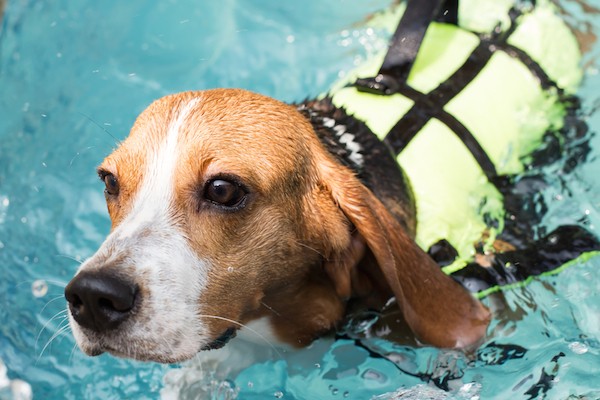Pet parents often mistakenly believe that cats fear water and canines love it. In reality, nothing could be further from the truth — in fact, many pet parents have a dog that’s afraid of water. One unfortunate example is my sweet Shih-Tzu mix, Grant.
When we first rescued Grant, we knew he’d been terribly mistreated and neglected. What we didn’t realize is that his residual fears also extended to water. We learned the hard way when we tried to coax him into a shallow pond. After extensive plying with tasty treats, our trembling pup bravely jumped in — then froze in panic and sunk. We instantly fished him out, but Grant was beside himself with terror. This led us to a profound appreciation for Cardinal Rule #1: Never force, push, coerce or throw a frightened canine into the water.
Fear of water in dogs can take on many different forms. Some pets simply dislike baths. Others may be startled by the sound of crashing waves or loud splashing. In extreme cases, certain canines even display anxiety around bowls of standing liquid. Some of these pups have been traumatized by a scary past experience.
Fortunately, many dogs can eventually be taught to overcome their aversion to water. This is a good thing, because bathing pooches periodically helps support a healthy coat. Swimming, moreover, can be a fantastic form of exercise — even for pets who struggle with pain, arthritis or injury.
What’s most important is that pet parents introduce fearful dogs to water gradually. Just like people, canines can develop negative associations. Bad experiences may cause existing fears to intensify. Caring, compassionate support is key. Consider these tips when dealing with a dog that’s afraid of water:

Beagle swimming by Shutterstock.
Introduce your dog to water very slowly.
If your dog struggles with a pronounced fear of water, start with extremely small exposures. Wait for a time of day when your pup is calm and relaxed. Pour a cup of water into a clean basin, and simply place this next to your dog. If your pup remains calm, offer praise. Eventually, dip your fingers into the water and let your pup sniff that hand. If your pup still seems calm, praise some more. Next, slowly run your wet hand over your pet’s fur. If your dog tolerates this calmly, praise him again. See the pattern? If your dog panics, stop. If your dog stays calm, continue to praise. Always reward the desired behavior. You may need to work with these exercises progressively, building up over multiple weeks.
Ease your dog’s fear of water with shallow wading.
If your dog seems fine with water proximity, fill a tub or kiddie pool with an inch or two of water. Make the temperature comfortably tepid, not hot or chilled. Pull together favorite treats, toys and a soft fluffy towel before gently placing your dog into the water. If your dog remains calm, praise continuously. You want your canine to begin associating water with consistent reward and encouragement.
Keep yourself relaxed around water, too!
Lee Deaton is founder and “leader of the pack” at Natural Healing, a canine hydrotherapy facility based in west suburban Chicago. She’s been helping dogs swim for more than 15 years — and she’s seen more than her share of nervous owners. “When pet owners feel anxious or frustrated, dogs sense it immediately,” she says. “Before taking your dog anywhere near deeper levels of water, it’s important to keep this in mind.
Give your dog an out — even if they like water and enjoy swimming.
For pet owners who have a pool at home, Deaton strongly recommends teaching canines two crucial things before anything else: 1) how to get in and out and 2) where to safely rest, should fatigue become an issue. Knowing how/where to exit or take a break can help canines feel much safer, she says. Sara Swan, owner of Narnia Pet Behavior and Training, agrees: “Dogs can tire out, just like people do,” she says. “First and foremost, you want to build trust in the water.”
Invest in a personal flotation device — it makes swimming easier and will keep frightened dogs afloat.
At Natural Healing, Deaton says she always uses Coast Guard-approved Ruffwear Dog Life Jackets. These vests add buoyancy, so a nervous canine won’t sink. They also produce a “swaddling” effect similar to that of a ThunderShirt. This helps ease respiration to keep dogs calmer. “Dogs wearing a life vest don’t need to work as hard — and if they panic, they won’t drown,” says Deaton. The handle on the back of these vests also allows you to guide a swimming dog without forcing. “Trying to forcibly steer canines,” she explains, “may cause them to resist you.”
Finally, look for qualified canine hydrotherapy facilities in your area. Skilled professionals like Deaton know how to help dogs swim, and they’ve been doing it for numerous years. Often, trained experts are more objective and less emotional than most pet parents. They make the owner part of the process, then enlist proven techniques to help canines build confidence quickly.
Thumbnail: Photography by Shutterstock.
Read more about dogs and water on Dogster.com:
- 6 Dogs Who Were Bred to Love the Water
- What Type of Water Alternatives Can Dogs Have?
- How Much Water Should a Dog Drink a Day?
The post Dealing with a Dog That’s Afraid of Water? Try These 4 Proven Techniques appeared first on Dogster.
No comments:
Post a Comment